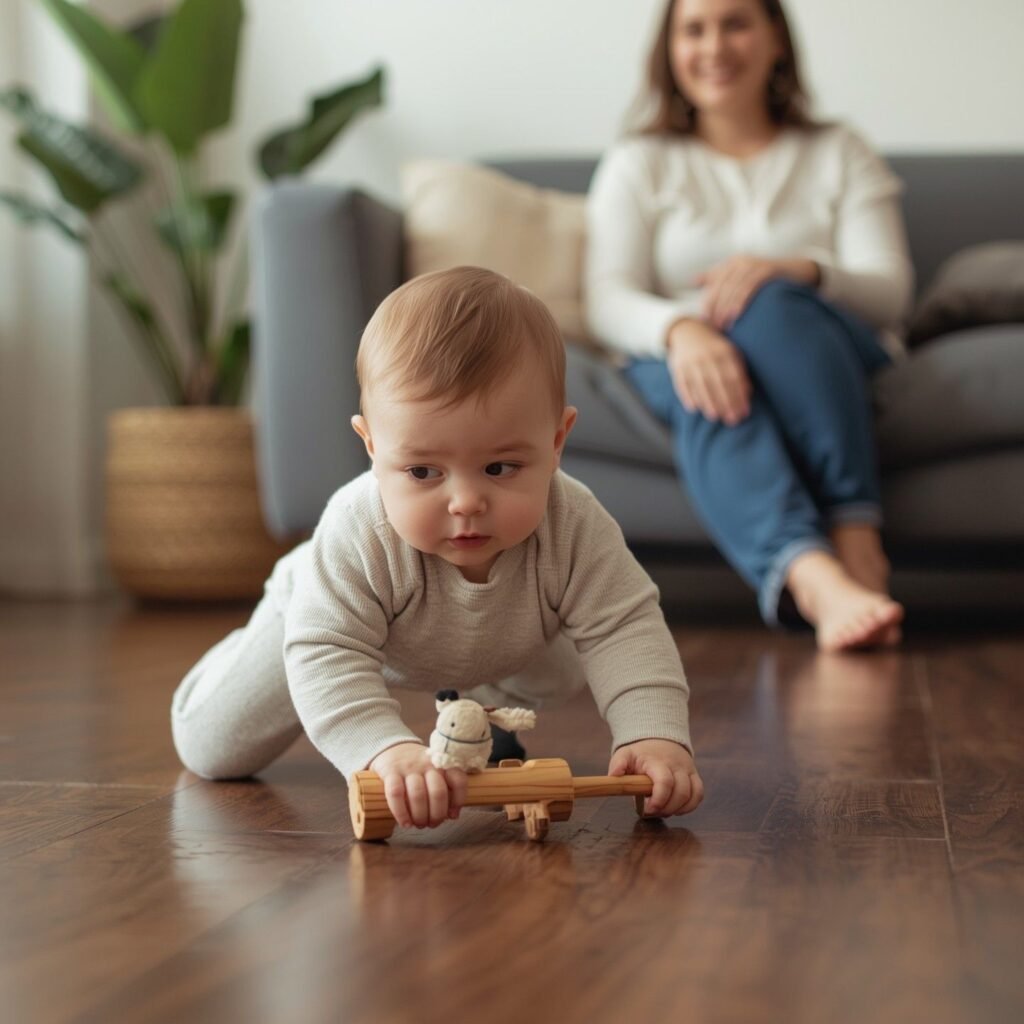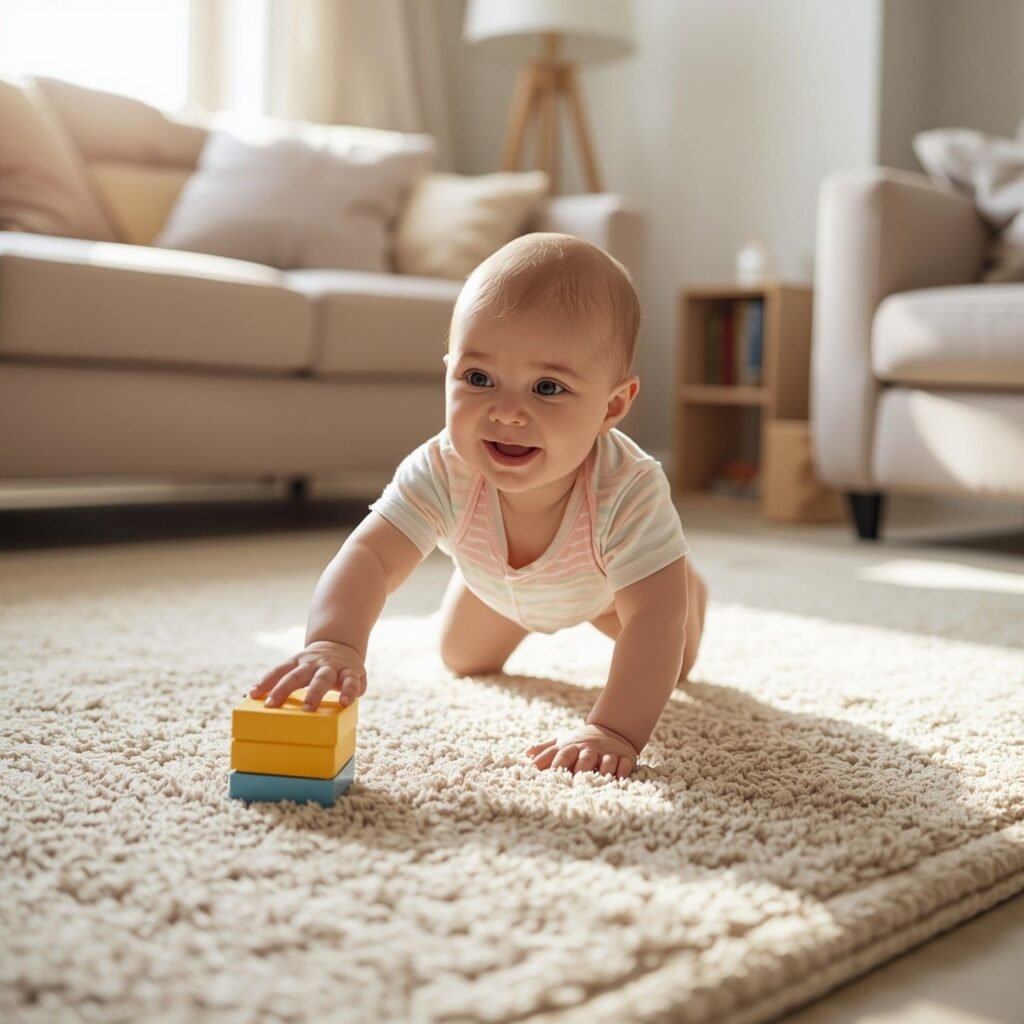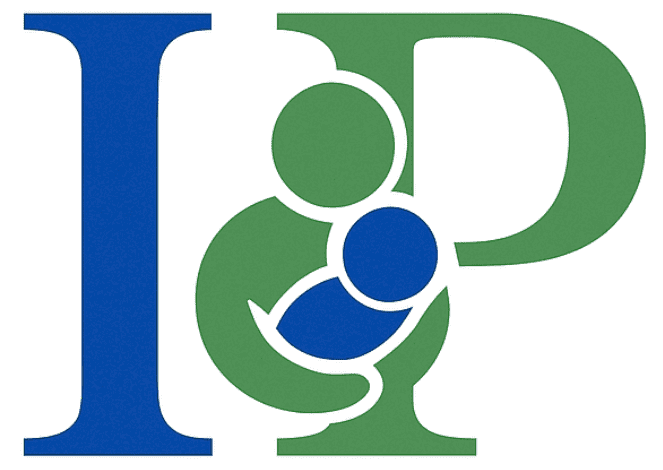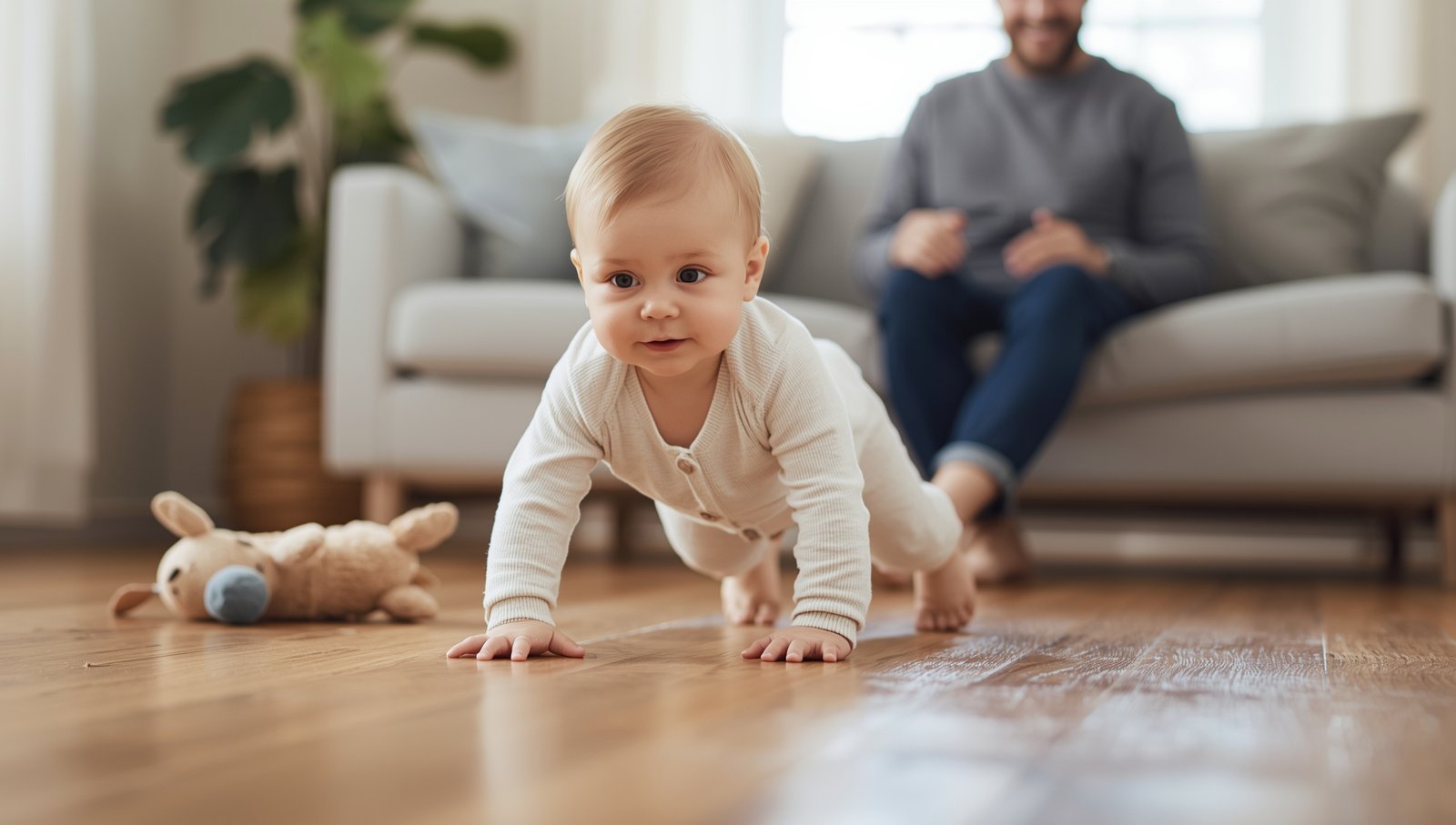As parents, it’s natural to feel proud, worried, and sometimes even a bit competitive when it comes to your baby’s milestones. You might be eagerly waiting for them to start crawling, rolling, or sitting up on their own. However, not every baby follows the traditional path. Some babies scoot instead of crawling, and this is perfectly normal! At INFANT PARENTING, we focus on the subtle and obvious signs of growth and development, helping you tune into your baby’s unique pace. Babies start to move in various ways, whether it’s creeping, scooting, or even skipping crawling altogether. It’s all part of their developmental process, and you can’t always predict what method they’ll choose to start exploring their world.
Seeing your baby scooting around on their bottom might leave you perplexed at first, but it’s an important milestone in their development. Whether they’re moving forward, backwards, or even using their legs to push off while scooting on their back, they are gaining control of their body. This phase may seem like a surprise to some parents, but it’s perfectly normal and just another step in preparing for bigger milestones like walking. Your baby may have their own ideas about how to move, and this preferred method of getting around is part of the fun and surprises of parenting. So, don’t worry if they’re scooting instead of crawling; it’s all part of the journey.

What is Scooting?
Scooting is an adorable way babies get around before they learn to crawl or walk. It’s often a prelude to crawling, and for some babies, it becomes their preferred style of movement. Babies usually start moving independently around 6 to 12 months, and you’ll notice them using their bottoms to scoot in different directions. Some babies might combine different styles, like scooting forward or backward, and others may keep it simple with one type. As babies pull up and start walking, scooting helps them develop the muscle strength and control they need for those bigger milestones. It’s also fun to watch how each baby has their own unique approach to getting around.
Types of Scooting
There are a few different types of scooting that babies can try as they develop their mobility. Some babies may choose bottom scooting, while others may experiment with sideways scooting or even start with belly crawling. Rolling around the floor is another way babies might get where they want to go. These types of scooting are all part of the developmental journey, and no matter which style your baby chooses, it’s a healthy sign of growth. Watching your baby try out these different movements is exciting because it shows how they are gaining control of their body. Each of these techniques has a purpose in helping them gain the strength and balance needed to transition to more advanced movements like walking.
1. Bottom Scooting
Bottom scooting is one of the more common ways babies get around. When babies scoot in a seated position, they use their arms to propel themselves either forward or backward. This movement helps babies build muscle strength in their arms and legs. It also allows them to practice balance and coordination as they learn to use both sides of their body equally. Watching your baby scoot can be both entertaining and encouraging as they figure out how to move their bodies in different ways. While some babies may scoot more often in one direction, others will mix things up and find their rhythm. Regardless, bottom scooting is a perfectly normal part of the developmental process.
2. Sideways Scooting
Sideways scooting is a unique way some babies move. They scoot along on their bottoms, much like a crab on the beach, moving from side to side. It’s fascinating to see babies learn how to maneuver their bodies in this way, using both legs and arms to get where they want to go. This type of scooting can be a fun and creative way for babies to experiment with movement before they are ready to crawl. It also helps them build the coordination and control needed for more complex movements as they grow. Sideways scooting can sometimes be a precursor to other forms of movement, like rolling or crawling.
3. Belly Crawling
When babies start belly crawling, they typically flop down on their bellies and use their arms to drag themselves forward, with their legs just going along for the ride. This type of movement, also known as combat crawling or the army crawl, is often a baby’s first real attempt at crawling. While they might not yet have the strength or coordination to get up on their hands and knees, belly crawling helps babies practice their upper body strength. It also strengthens their legs as they push off the floor. Belly crawling is an important phase in the journey to walking and crawling, so don’t be alarmed if your baby starts with this style.
4. Rolling
Some babies prefer to roll on the floor to get where they want to go. This is often their first way of moving independently, and many babies use rolling as a fun way to explore their surroundings before they start crawling. It’s a natural part of the developmental process, and it shows that your baby is gaining the control they need to eventually master other types of movement. Watching babies roll with such joy and ease is a reminder that there’s no one “right” way for them to develop, and each baby will find their own attitude and path towards movement.
Curious About the Average Ranges for Your Baby’s Various Forms of Locomotion? Find Out What’s Normal!

When does it generally start?
Experts suggest that scooting usually begins around the 6 to 12 months’ mark, with babies making their first attempts between 6 and 10 months. It often starts when babies can sit unassisted, and it can take a little time for them to gain the confidence to move. You may notice them rocking back and forth or trying to get around in other ways, like creeping or crawling. The process of scooting can vary, with some babies moving forward or even backward, while others take a more leisurely approach. It’s not uncommon for babies to experiment with different movements, including rolling over and sitting up, as they work their way toward bigger milestones.
1-Scooting on Belly (Backward)
Scooting on the belly backwards is a typical behavior for babies between 7 and 8 months. During this stage, babies often scoot by using their legs to push off while lying on their bellies. While it may seem like a backward movement, it’s a sign of growth and muscle development. This type of movement helps babies practice using their bodies and improving strength, and is often one of the first signs that they’re getting ready for more advanced forms of movement, like crawling or sitting.
2-Scooting on Belly (Forward)
When babies scoot forward on their bellies, typically around 8 to 9 ½ months, they begin using their arms to pull themselves while pushing with their legs. This movement is similar to combat crawling or the army crawl. It’s an important developmental phase as babies practice strength, coordination, and balance. You’ll notice that their arms and legs work together in a way that will eventually help them with more traditional crawling and, eventually, walking.
3-Crawling with belly off the floor
Around 6 to 10 months, babies start to crawl with their bellies off the floor. This marks a significant milestone in their physical development as they begin to strengthen their hands, knees, and core muscles. Crawling is an important step before they start pulling up or attempting to walk. Babies may go through various styles of crawling, including the belly crawl or commando crawl, and it’s all part of their developmental journey. During this time, their ability to balance and move with more control grows stronger.

How do different ages start scooting?
Throughout the first year, babies develop muscle strength and control that help them move. Scooting is an important step in this process before they can walk. During this time, babies start to experiment with different ways of moving, from creeping to scooting and eventually crawling. These early movements are all essential for their development, helping them strengthen their body and prepare for more complex physical activities.
1-Newborn
As a newborn, your baby’s neck and head control are still developing. At this stage, they rely on tummy time to build their strength. Although they can’t scoot yet, this period is vital for setting the foundation for future physical skills. Tummy time helps babies develop the muscle strength needed for rolling over, scooting, and even crawling later on.
2-One to Two months
From 1 to 2 months, babies start getting stronger and learning to lift and turn their head during tummy time. This is the time when they begin gaining better control over their body. While they aren’t scooting yet, these early movements help set the stage for more advanced skills like crawling and sitting unassisted. It’s an exciting time when your baby’s growth becomes more obvious.
3-Three to Six months
Between 3 to 6 months, your baby gains more control over their head and body. They start doing mini push-ups during tummy time, strengthening their arms and core. By 6 months, they may begin to sit with some assistance. This is also the stage when babies start experimenting with rolling over, moving from front to back and back to front, as well as trying scooting and crawling.
4-Seven to eight months
By 7 to 8 months, babies can control their movements better and might begin scooting from a seated position. Some may move backwards or stay put, while others begin rolling on the floor. At this age, babies might experiment with scooting or sitting, trying different movements to get around and explore their surroundings.
5-Nine to Ten months
At 9 to 10 months, babies are often in a sitting position, using their support to transition to all fours and begin crawling. They can also scoot forward, and some even begin to try standing and walking. While every baby’s journey is different, many might skip crawling altogether, choosing to move in their own way to reach new milestones.
How to help your baby move forward?
To encourage your baby’s movement, you can start by putting them in a short-sleeved onesie so their skin can grip the floor more easily. Place them on a smooth surface, like a hardwood floor, instead of a rug or blanket, for better traction. During tummy time, roll a ball just out of reach to entice your baby to move. As they work towards getting the ball, resist the urge to move it farther away. You can also create an obstacle course using big pillows to help build their muscles and challenge their new skills as they continue to explore movement.
Precautions to take when your Champ/Prince is on the Move
As soon as babies start moving, things can get a little wild. They may be scooting, creeping, or just exploring around at full speed. As they become more mobile, it’s important to baby-proof your home to prevent accidents. Make sure that dangerous things like cleaning supplies, toiletries, and sharp utensils are safely out of reach. Use locks and latches on bathroom and kitchen cabinets, and install safety latches on drawers. Don’t forget to secure furniture, TVs, and anything that can tip over. You also want to use protective guards for sharp corners and cover any exposed electrical cords. Swimming pools, garages, and outdoor spaces need extra care, too.
Essential Baby Milestones: When Do Babies Sit Up, Roll Over, and Crawl?
Watching your baby grow and change during the first few years is a great experience. Babies hit developmental milestones such as learning to sit up, roll over, and crawl at different times, but there are some general guidelines. During tummy time, babies start by strengthening their neck muscles, and as they grow, they learn to push up on their arms. By 4 months, they may start rocking back and forth, getting ready to sit and roll. Around 6 months, babies may start sitting with some support. By 9 months, many babies start moving on their hands and knees, and by 12 months, they may be cruising around. Encouraging them with a favorite toy or book can help!
How to Encourage Scooting and Crawling?
Encouraging your baby to start crawling or scooting is an exciting part of their growth. Babies have their own style and preference when it comes to movement, whether it’s scooting, belly crawling, or even creeping. The key is to give them incentives to move. Make sure your baby has enough tummy time and a safe area where they can explore. Place a toy or object just out of reach to spark their interest, encouraging them to wiggle and reach. It’s important not to force or prematurely discourage them; they need the freedom to practice at their own pace. Giving them extra free time and opportunities to move freely, like avoiding too much time in a stroller, swing, or crib, helps them develop their skills naturally.
When to worry about the baby’s movement?
As a parent, it’s normal to worry about your baby’s progress with scooting, crawling, or moving in general. However, milestones vary from baby to baby. If your baby shows no interest in scooting or creeping by their first birthday, it’s a good idea to check in with your pediatrician. Minor delays in crawling or scooting can be perfectly fine, but concerning movements such as dragging their side or not being able to move forward may need a professional evaluation. Keep an eye on their body movements and show your doctor any unusual signs. A video of their movement can also be helpful during a visit.
FAQS
Why is my baby scooting backwards on their back?
It’s quite common for babies to scoot backwards while lying on their backs. This movement can look ridiculous to some parents, but it’s completely normal. Babies often push off with their heels and scoot in a backward direction across the floor. This movement is not only fun to watch, but it’s also an effective leg exercise that helps develop upper-body strength and arms. As babies grow, they will eventually learn how to move forward, and the backward scooting will fade as they gain more control over their legs and body.
What if my child doesn’t scoot?
It’s natural to be concerned if your baby doesn’t scoot or crawl by a certain age. However, it’s important to remember that babies develop at their own pace. Some may take longer to start moving, and that’s perfectly normal. If your baby is not moving in both directions or showing interest in crawling, it might just mean they are still developing the strength and coordination needed. If this continues after your baby’s first birthday, consider talking to your doctor to rule out any developmental delay. Every baby is unique, and a pediatrician can offer helpful advice based on your baby’s developmental progress.
After Scooting, What’s Next for my Baby?
Once your baby has mastered scooting, you can expect their movements to evolve quickly. After scooting, many babies move on to crawling, but some might skip this stage entirely. As they grow in confidence, they’ll start to cruise along furniture, maybe even using a walker or taking their first steps. Eventually, they’ll be ready to run, jump, and dance. These movements are key milestones in their development, giving them a new sense of freedom as they explore the world around them with growing curiosity.
When Can I Expect My Baby to Crawl?
The journey to crawling is one of the most exciting developmental milestones for parents. Most babies will start crawling between 6 to 10 months, but some may start later depending on their own style and developmental pace. Crawling offers your baby newfound independent mobility, allowing them to explore their environment and discover new things. This period is also critical for their motor and physical development, as it helps them strengthen their arms, legs, and core. Keep in mind that every child’s development is unique, so be patient and enjoy the journey of watching your little one grow and change.

